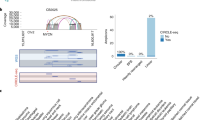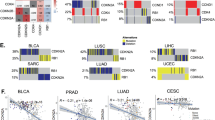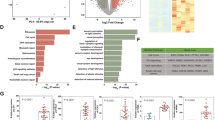Abstract
Gain of chromosome 1q31–1q32 is seen in >50% of retinoblastoma and is common in other tumors. To define the minimal 1q region of gain, we determined genomic copy number by quantitative multiplex PCR of 14 sequence tagged sites (STSs) spanning 1q25.3–1q41. The most frequently gained STS at 1q32.1 (71%; 39 of 55 retinoblastoma) defined a 3.06 Mbp minimal region of gain between flanking markers, containing 14 genes. Of these, only KIF14, a putative chromokinesin, was overexpressed in various cancers by real-time RT–PCR. KIF14 mRNA was expressed in 20/22 retinoblastoma samples 100–1000-fold higher than in retina (t-test P=0.00002); cell lines (n=10) had higher levels than tumors (n=12) (P=0.009). KIF14 protein was overexpressed in retinoblastoma tumors and breast cancer cell lines by immunoblot. KIF14 was expressed in 4/4 breast cancer cell lines 31–92-fold higher than in normal breast tissue, in 5/5 medulloblastoma cell lines 22–79-fold higher than in fetal brain, and in 10/22 primary lung tumors 3–34-fold higher than in normal lung. Patients with lung tumors that overexpress KIF14 showed a trend toward decreased survival. KIF14 may thus be important in oncogenesis, and has promise as a prognostic indicator and therapeutic target.
This is a preview of subscription content, access via your institution
Access options
Subscribe to this journal
Receive 50 print issues and online access
$259.00 per year
only $5.18 per issue
Buy this article
- Purchase on Springer Link
- Instant access to full article PDF
Prices may be subject to local taxes which are calculated during checkout





Similar content being viewed by others
References
Alphey L, Parker L, Hawcroft G, Guo Y, Kaiser K and Morgan G . (1997). J. Cell Biol., 138, 395–409.
Bailey JA, Yavor AM, Massa HF, Trask BJ and Eichler EE . (2001). Genome Res., 11, 1005–1017.
Baudis M and Cleary ML . (2001). Bioinformatics, 17, 1228–1229.
Bertuzzi S, Porter FD, Pitts A, Kumar M, Agulnick A, Wassif C and Westphal H . (1999). Mech. Dev., 81, 193–198.
Blackhall FH, Wigle DA, Jurisica I, Pintilie M, Liu N, Darling G, Johnston MR, Keshavjee S, Waddell T, Winton T, Shepherd FA and Tsao MS . (2004). Lung Cancer, 46, 197–204.
Chen D, Gallie BL and Squire JA . (2001). Cancer Genet. Cytogenet., 129, 57–63.
Chen D, Pajovic S, Duckett A, Brown VD, Squire JA and Gallie BL . (2002). Cancer Res., 62, 967–971.
Classon M and Harlow E . (2002). Nat. Rev. Cancer, 2, 910–917.
DeBonis S, Skoufias DA, Lebeau L, Lopez R, Robin G, Margolis RL, Wade RH and Kozielski F . (2004). Mol. Cancer Ther., 3, 1079–1090.
DiCiommo D, Gallie BL and Bremner R . (2000). Semin. Cancer Biol., 10, 255–269.
Dimova DK, Stevaux O, Frolov MV and Dyson NJ . (2003). Genes Dev., 17, 2308–2320.
Evans AJ, Gallie BL, Jewett MA, Pond GR, Vandezande K, Underwood J, Fradet Y, Lim G, Marrano P, Zielenska M and Squire JA . (2004). Am. J. Pathol., 164, 285–293.
Gallie BL, Campbell C, Devlin H, Duckett A and Squire JA . (1999a). Cancer Res., 59, 1731s–1735s.
Gallie BL, Trogadis J and Han L . (1999b). Human Cell Culture Masters J (ed). Kluwer: New York, pp. 361–374.
Hackett CS, Hodgson JG, Law ME, Fridlyand J, Osoegawa K, de Jong PJ, Nowak NJ, Pinkel D, Albertson DG, Jain A, Jenkins R, Gray JW and Weiss WA . (2003). Cancer Res., 63, 5266–5273.
Herzog S, Lohmann DR, Buiting K, Schuler A, Horsthemke B, Rehder H and Rieder H . (2001). Hum. Genet., 108, 98–104.
Höglund M, Gisselsson D, Hansen GB, Sall T and Mitelman F . (2002). Cancer Res., 62, 2675–2680.
Knudson Jr AG . (1971). Proc. Natl. Acad. Sci. USA, 68, 820–823.
Le Roy H, Ricoul M, Ogata H, Apiou F and Dutrillaux B . (1993). Genes Chromosomes Cancer, 6, 156–160.
Leizerman I, Avunie-Masala R, Elkabets M, Fich A and Gheber L . (2004). Cell. Mol. Life Sci., 61, 2060–2070.
Levesque AA, Howard L, Gordon MB and Compton DA . (2003). Mol. Biol. Cell, 14, 3541–3552.
Lillington DM, Goff LK, Kingston JE, Onadim Z, Price E, Domizio P and Young BD . (2002). Br. J. Cancer, 87, 779–782.
Mairal A, Pinglier E, Gilbert E, Peter M, Validire P, Desjardins L, Doz F, Aurias A and Couturier J . (2000). Genes Chromosomes Cancer, 28, 370–379.
Marchong MN, Chen D, Corson TW, Lee C, Harmandayan M, Bowles E, Chen N and Gallie BL . (2004). Mol. Cancer Res., 2, 495–503.
Mayer TU, Kapoor TM, Haggarty SJ, King RW, Schreiber SL and Mitchison TJ . (1999). Science, 286, 971–974.
Miki H, Setou M, Kaneshiro K and Hirokawa N . (2001). Proc. Natl. Acad. Sci. USA, 98, 7004–7011.
Molina I, Baars S, Brill JA, Hales KG, Fuller MT and Ripoll P . (1997). J. Cell Biol., 139, 1361–1371.
Nakagawa T, Tanaka Y, Matsuoka E, Kondo S, Okada Y, Noda Y, Kanai Y and Hirokawa N . (1997). Proc. Natl. Acad. Sci. USA, 94, 9654–9659.
Nomura N, Nagase T, Miyajima N, Sazuka T, Tanaka A, Sato S, Seki N, Kawarabayasi Y, Ishikawa K and Tabata S . (1994). DNA Res., 1, 251–262.
Ohkura H, Torok T, Tick G, Hoheisel J, Kiss I and Glover DM . (1997). J. Cell Sci., 110 (Part 8), 945–954.
Oliveros O and Yunis E . (1995). Cancer Genet. Cytogenet., 82, 155–160.
Ota T, Suzuki Y, Nishikawa T, Otsuki T, Sugiyama T, Irie R, Wakamatsu A, Hayashi K, Sato H, Nagai K, Kimura K, Makita H, Sekine M, Obayashi M, Nishi T, Shibahara T, Tanaka T, Ishii S, Yamamoto J, Saito K, Kawai Y, Isono Y, Nakamura Y, Nagahari K, Murakami K, Yasuda T, Iwayanagi T, Wagatsuma M, Shiratori A, Sudo H, Hosoiri T, Kaku Y, Kodaira H, Kondo H, Sugawara M, Takahashi M, Kanda K, Yokoi T, Furuya T, Kikkawa E, Omura Y, Abe K, Kamihara K, Katsuta N, Sato K, Tanikawa M, Yamazaki M, Ninomiya K, Ishibashi T, Yamashita H, Murakawa K, Fujimori K, Tanai H, Kimata M, Watanabe M, Hiraoka S, Chiba Y, Ishida S, Ono Y, Takiguchi S, Watanabe S, Yosida M, Hotuta T, Kusano J, Kanehori K, Takahashi-Fujii A, Hara H, Tanase TO, Nomura Y, Togiya S, Komai F, Hara R, Takeuchi K, Arita M, Imose N, Musashino K, Yuuki H, Oshima A, Sasaki N, Aotsuka S, Yoshikawa Y, Matsunawa H, Ichihara T, Shiohata N, Sano S, Moriya S, Momiyama H, Satoh N, Takami S, Terashima Y, Suzuki O, Nakagawa S, Senoh A, Mizoguchi H, Goto Y, Shimizu F, Wakebe H, Hishigaki H, Watanabe T, Sugiyama A, Takemoto M, Kawakami B, Watanabe K, Kumagai A, Itakura S, Fukuzumi Y, Fujimori Y, Komiyama M, Tashiro H, Tanigami A, Fujiwara T, Ono T, Yamada K, Fujii Y, Ozaki K, Hirao M, Ohmori Y, Kawabata A, Hikiji T, Kobatake N, Inagaki H, Ikema Y, Okamoto S, Okitani R, Kawakami T, Noguchi S, Itoh T, Shigeta K, Senba T, Matsumura K, Nakajima Y, Mizuno T, Morinaga M, Sasaki M, Togashi T, Oyama M, Hata H, Komatsu T, Mizushima-Sugano J, Satoh T, Shirai Y, Takahashi Y, Nakagawa K, Okumura K, Nagase T, Nomura N, Kikuchi H, Masuho Y, Yamashita R and Nakai K et al. (2004). Nat. Genet., 36, 40–45.
Retaux S, Rogard M, Bach I, Failli V and Besson MJ . (1999). J. Neurosci., 19, 783–793.
Richter S, Vandezande K, Chen N, Zhang K, Sutherland J, Anderson J, Han L, Panton R, Branco P and Gallie B . (2003). Am. J. Hum. Genet., 72, 253–269.
Ruden DM, Cui W, Sollars V and Alterman M . (1997). Dev. Biol., 191, 284–296.
Sakowicz R, Finer JT, Beraud C, Crompton A, Lewis E, Fritsch A, Lee Y, Mak J, Moody R, Turincio R, Chabala JC, Gonzales P, Roth S, Weitman S and Wood KW . (2004). Cancer Res., 64, 3276–3280.
Sargent LM, Senft JR, Lowry DT, Jefferson AM, Tyson FL, Malkinson AM, Coleman AE and Reynolds SH . (2002). Cancer Res., 62, 1152–1157.
Schreiner B, Baur DM, Fingerle AA, Zechner U, Greten FR, Adler G, Sipos B, Kloppel G, Hameister H and Schmid RM . (2003). Genes Chromosomes Cancer, 38, 240–248.
Smith AN, Borthwick KJ and Karet FE . (2002). Gene, 297, 169–177.
Squire J, Gallie BL and Phillips RA . (1985). Hum. Genet., 70, 291–301.
Trowbridge IS, Ostergaard HL and Johnson P . (1991). Biochim. Biophys. Acta, 1095, 46–56.
van Berlo RJ, de Jong B, Oosterhuis JW, Dijkhuizen T, Buist J and Dam A . (1990). Cancer Res., 50, 3416–3421.
van der Wal JE, Hermsen MA, Gille HJ, Schouten-Van Meeteren NY, Moll AC, Imhof SM, Meijer GA, Baak JP and van der Valk P . (2003). J. Clin. Pathol., 56, 26–30.
Yan RT and Wang SZ . (1997). Gene, 189, 263–267.
Acknowledgements
We thank S Pajovic and all members of the Gallie Laboratory for insightful input, Lisa Wang for statistical assistance, Solutions by Sequence Inc. (Toronto Western Hospital) for the use of equipment for QM-PCR, and D Bigner (Duke University), S Done, M Minden, and C Paige (OCI) for cell lines. This work was supported by grants to BLG from the National Cancer Institute of Canada with funds from the Terry Fox Run and the Canadian Cancer Society, the Canadian Genetic Diseases Network and the Canadian Institutes for Health Research, and by the Keene Retinoblastoma Perennial Plant Sale. TWC was supported by a Canadian Institutes of Health Research Canada Graduate Scholarship, a Natural Sciences and Engineering Research Council Postgraduate Scholarship, and a University of Toronto Vision Science Research Program Studentship.
Author information
Authors and Affiliations
Corresponding author
Rights and permissions
About this article
Cite this article
Corson, T., Huang, A., Tsao, MS. et al. KIF14 is a candidate oncogene in the 1q minimal region of genomic gain in multiple cancers. Oncogene 24, 4741–4753 (2005). https://doi.org/10.1038/sj.onc.1208641
Received:
Revised:
Accepted:
Published:
Issue Date:
DOI: https://doi.org/10.1038/sj.onc.1208641
Keywords
This article is cited by
-
KIF21A regulates breast cancer aggressiveness and is prognostic of patient survival and tumor recurrence
Breast Cancer Research and Treatment (2022)
-
Single Nucleotide Variants in KIF14 Gene May Have Prognostic Value in Breast Cancer
Molecular Diagnosis & Therapy (2022)
-
Overexpressed XRCC2 as an independent risk factor for poor prognosis in glioma patients
Molecular Medicine (2021)
-
Structural basis of mechano-chemical coupling by the mitotic kinesin KIF14
Nature Communications (2021)
-
Adverse histology, homozygous loss of CDKN2A/B, and complex genomic alterations in locally advanced/metastatic renal mucinous tubular and spindle cell carcinoma
Modern Pathology (2021)



